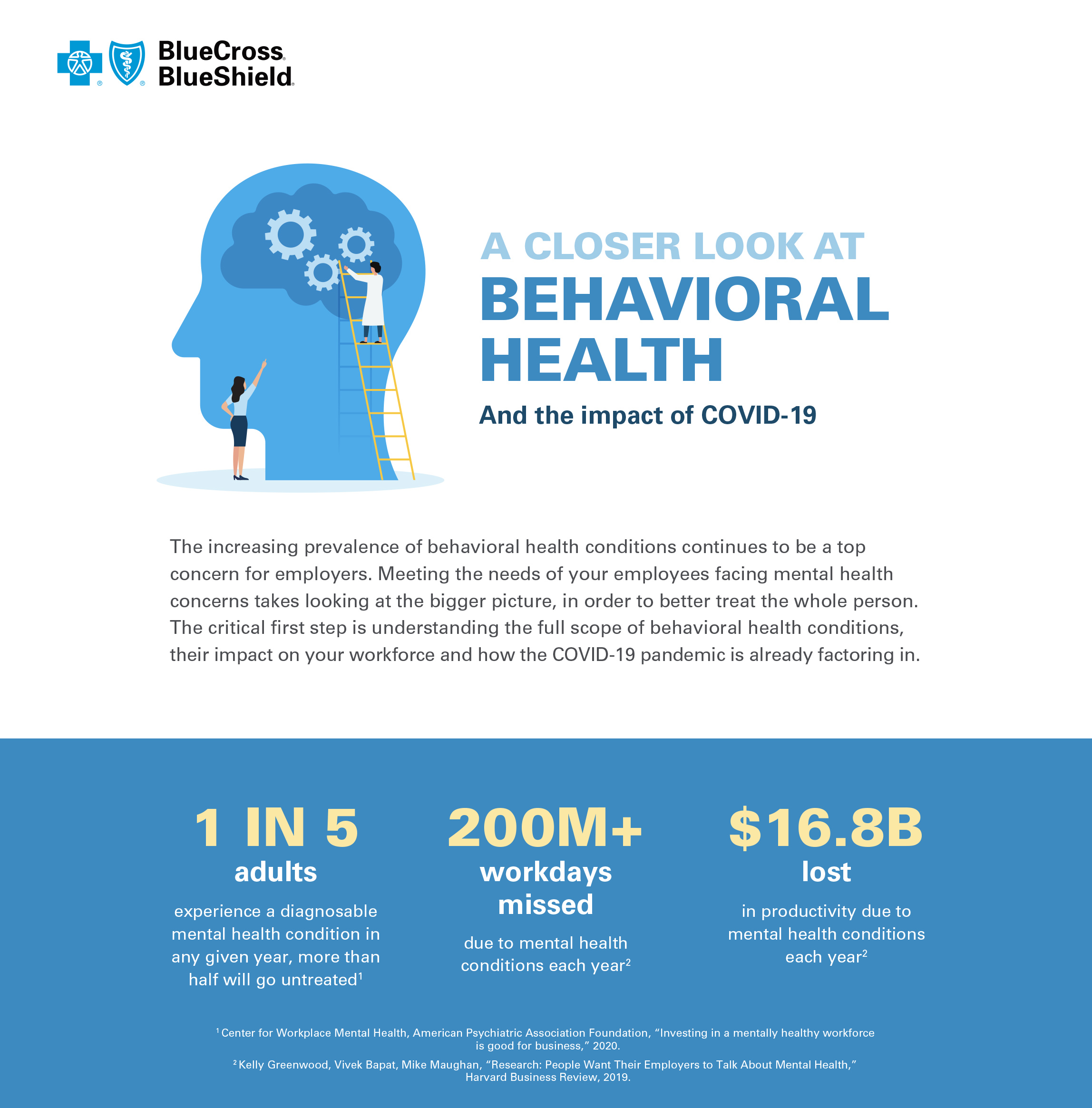
Increasing Access to Behavioral Healthcare in the Face of COVID-19
July 2020
Vincent Nelson, M.D., Vice President, Medical Affairs, Blue Cross Blue Shield Association
America was in the midst of a behavioral health crisis even before the world had ever heard of COVID-19. In fact, six out of the top 10 health conditions affecting Millennials alone—the future generation of the US workforce—are behavioral health conditions.1 Access to behavioral healthcare was also in crisis before the coronavirus pandemic, with the leading barriers to care being cost and availability. Not knowing where to find proper care, and not being able to afford it when they do, leads employees who need help to go untreated. In fact, 47 percent of Millennials have delayed or avoided medical treatment because of healthcare costs.2 And as Millennials get older, the cost of treatment—for both employers and employees—will only increase.
The coronavirus pandemic has significantly impacted our nation’s mental health, creating new obstacles for people already struggling from a behavioral health condition. As the pandemic continues, Americans are reporting sharply elevated levels of anxiety and stress. This creates new urgency around providing your employees behavioral healthcare that’s easier to access and more affordable.
SOLVING FOR SILOED CARE THAT COMPLICATES TREATMENT AND INCREASES COSTS
Increase access to integrated care.
Historically, the number one barrier between employees and behavioral healthcare has been cost, much of which is driven by the siloed nature of our healthcare system.3 Increasing access to integrated care is critical, considering 68 percent of people with a behavioral health condition also have a medical comorbidity, or a secondary underlying health condition, such as heart disease or diabetes.4 And, healthcare costs for treating employees with behavioral and chronic medical conditions are 2-3X higher than for those without behavioral health conditions.5
Reevaluate the cost-care relationship.
While it’s true behavioral and physical health are linked and are equally important to overall health, behavioral health conditions do require more regular management and check-ins. This means using the same payment structure as we do for physical health can cause costs to stack up quickly. But, changing that structure even slightly can have a big impact. A recent study by leading virtual behavioral healthcare provider AbleTo revealed that employee engagement doubled just by eliminating a $10 copay.6
Bring more behavioral health in network.
Networks need to provide better access to more behavioral health support. Employers can play a major role in driving this change by asking their healthcare partner to include in-network providers that offer more integrated, multidimensional care models. They can also work with their healthcare partners to explore new ways to approach copays and premiums.
“Much of the feedback we received was that people don’t access [behavioral health] services because they can’t afford them. Allowing the member to receive those services included in the premium that they’re already paying has made a tremendous difference,” says Erin Stucky, president and CEO, Blue Cross and Blue Shield of Kansas City.
PRACTICING SPECIALISTS ARE INCREASINGLY HARD TO FIND
After cost, availability creates another critical barrier to care, in terms of provider shortages and challenges related to scheduling and visits. In fact, two out of five Americans live in areas designated by the federal government as having a shortage of behavioral healthcare providers.7
Therapy and substance use disorder treatment are areas of top concern.
Over 60 percent of practicing psychiatrists are over the age of 55, according to data from the Association of American Medical Colleges (AAMC).8 Meanwhile, the need for treatment is expected to rise.9 A recent study published in Psychiatric Services, revealed that six out of 10 initial phone calls made to outpatient psychiatrists went unanswered. Yet even after two calls, appointments were secured with only about one-quarter of the doctors, and the average waiting time for a first visit was 25 days.10
When it comes to tackling substance use disorder, drug overdoses are now the leading cause of accidental death in the US.11 And, the rising costs of addiction related to crime, lost work productivity and healthcare exceed $700 billion annually.12 Substance use disorder is also within the top five behavioral health conditions, and yet many treatment centers are out-of-network, making them harder to access, afford and know how to vet.
Innovative partnerships are helping to find solutions.
For an example, look at what Blue Cross and Blue Shield of North Carolina (Blue Cross NC) is doing with Shatterproof, a national nonprofit organization dedicated to reversing the addiction crisis in America. Blue Cross NC is working with Shatterproof to establish a quality measurement system for addiction treatment programs in North Carolina and nationally. Their business model is similar to how consumers use Yelp to find restaurants, stores, etc., by helping patients and their families with a quick and easy way to find high-quality treatment options for substance use disorders through its web and application-based search platform.
Susan Foosness, senior business operations advisor in behavioral health at Blue Cross NC explains, “Shatterproof brings together assessments by public and private payers—using data from the programs themselves and survey responses from consumers who went through the programs—to give the provider/option a report card. This expands access while providing transparency and a reliable sense of value, for both employees and employers.”
COVID-19 INTENSIFIES THE NEED FOR BEHAVIORAL HEALTHCARE
Even before the pandemic hit, Millennials—who now comprise half of America’s workforce—were already the most stressed generation in history.13 Since the COVID-19 pandemic, Americans are reporting significant and sustained increases in symptoms of depression and anxiety. Daily routines, both personal and professional, have been upended, increasing physical, mental and financial strain.
These stressors, together, create a kind of perfect storm for an increase in the development of mental health conditions. And, data in our most recent infographic suggests that negative behavior among Millennials has also been rising since the pandemic began.

One thing that employers should be exploring with their healthcare partner is making no-cost screenings standard practice. Independence Blue Cross, for example, offers a free, confidential online program called On to Better Health designed to help its members improve their emotional well-being with self-assessments, articles, videos, and personalized and guided therapy available 24/7. The program provides quick assessment through a mental health screener that leads to a personalized list of available online programs and resources, including evidence-based cognitive behavioral therapy. This way, employees can better learn and practice skills to manage their mild anxiety, depression, and alcohol or substance use disorder. Should a member screen at higher risk, there is an automatic referral to Behavioral Health case management.
EMPLOYERS ARE BRINGING BEHAVIORAL HEALTHCARE WITHIN REACH
Prior to COVID-19, employers, too, were already increasing efforts to make behavioral healthcare accessible for their employees. Now, they’re ramping up even more. These include changes in employee assistance programs (EAPs), from discounts on digital care apps to more virtual well-being service options like remote yoga classes.13 “More than half of large employers are planning to expand the range of telehealth benefits offered in 2020 to include services such as virtual mental-health counseling,” said Ellen Kelsay, president and CEO of the Business Group on Health. As we transition back to the workplace, more large employers may also look to bring clinicians and counselors onsite.
Tele-behavioral health and virtual care apps are a natural fit. These solutions provide convenience for employees through fluid scheduling, easier connections to care professionals, and improved access without the stigma of seeking help. From evidence-based cognitive behavioral therapy to resiliency digital tools, these platforms offer multiple ways for employees to connect with practitioners, from live audio and video chat to instant messaging.
A global example of removing care barriers is GeoBlue®, the international solution for Blue Cross and Blue Shield companies. Telehealth services are critical for those living and working in a foreign country as a new environment can often bring language limitations and unfamiliar healthcare systems. To support their members, GeoBlue offers culturally appropriate telehealth solutions for both physical and mental health needs, providing members with confidential access to counselors and wellness coaches around the world. Taking a holistic approach to care, GeoBlue also helps minimize stress by providing referrals to local resources such as legal counsel or childcare providers. Earlier this year, to round out their telehealth proposition, GeoBlue launched its multilingual, remote-consultation Global TeleMD™ app, making secure phone or video calls with doctors accessible anywhere in the world, simplifying access to trusted care when and where members need it.
IMPROVING ACCESS: THIS IS HOW
Here’s what employers can do to help make powerful change happen and improve their employees’ access to better healthcare.
Expand resources.
Help employees connect with the care they need by expanding your behavioral health resources and improving access points—from virtual care to on-demand or on-site clinicians and counseling. Ask your healthcare partner to include and expand in-network providers that offer a multidimensional care model and for resources that help your employees find them.
Make virtual care a priority.
Examine your employees’ virtual care usage since March and consider making changes brought on by the COVID-19 pandemic permanent. Ask your healthcare partner about resources that can help employees know which ones are right for them.
Get smart about affordability and screenings.
Explore ways with your healthcare partner to lower or remove copays when it comes to behavioral health, where check-ins are needed more often. Also, make no-cost screenings standard similar to preventive care—to create stigma-free dialogue with a professional who can explain results and help employees find the right assistance.
Drive awareness.
Foster a deeper understanding of the connection between behavioral healthcare and physical healthcare and use internal communications to promote the quality, affordability and effectiveness of available resources.
© 2020 Blue Cross Blue Shield Association. All Rights Reserved. The Blue Cross Blue Shield Association is an association of independent, locally operated Blue Cross and Blue Shield companies. The information contained on this website is not intended for individuals located outside of the United States.
1,2 Blue Cross Blue Shield Health of America National Generation Survey, 2019.
3 Greenberg and Pande, Barriers to Behavioral Health Care, AbleTo, 2018.
4 Goodall, et al., National Council for Behavioral Health, “Mental Disorders and Medical Comorbidity,” Substance Abuse and Mental Health Services Administration, 2011.
5 Milliman Research Report, “Potential Economic Impact of Integrated Medical-Behavioral Healthcare, Implications for Psychiatry,” 2014.
6 Sourced from AbleTo, Commercial Health Plan Analysis, 2016.
7 Blue Cross and Blue Shield of North Carolina, HealthCare Solutions.
8,9 Weiner, “Addressing the Escalating Psychiatrist Shortage,” AAMC, 2018.
10 Psychiatry Advisor, “Long Wait Times Typical for Psychiatry Appointments,” 2014.
11 Cullen, “Opioid overdoses kill more people in the U.S. than guns or breast cancer,” New York Daily News, 2017.
12 NIDA, “Trends and Statistics,” 2015.
13 American Psychological Association (APA), “Stress in America™: Generation Z,” 2018.

 Vincent Nelson, M.D., is vice president of medical affairs in the Office of Clinical Affairs (OCA) for the Blue Cross Blue Shield Association (BCBSA), a national federation of 36 independent, community-based and locally operated Blue Cross and Blue Shield (BCBS) companies. Today, one in three Americans are covered by the BCBS System.
Vincent Nelson, M.D., is vice president of medical affairs in the Office of Clinical Affairs (OCA) for the Blue Cross Blue Shield Association (BCBSA), a national federation of 36 independent, community-based and locally operated Blue Cross and Blue Shield (BCBS) companies. Today, one in three Americans are covered by the BCBS System.

